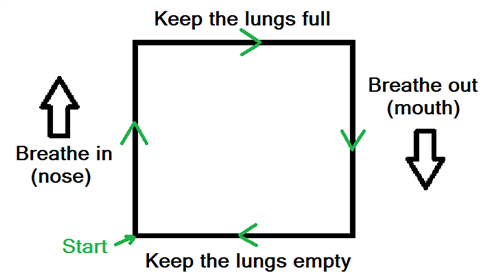- Independence High School
- Calming and Coping Resources
- Coping Strategies
Abono, Shannon - Counselor
Page Navigation
-
If you’re feeling the emotional and mental weight of this moment, you’re not alone. Trying even a few simple tasks can help us all thrive together even while we’re apart.
How to protect yourself and others
Find your words
The discomfort you are feeling is grief
Simple Breathing Exercise
-
Sit or lay in a comfortable position
-
Eyes can be open or closed
-
Inhale through your nose for 4 counts, then exhale for 4 counts
-
Repeat for 5 to 10 minutes
Box Breathing
-
- Visualise a square. You’re starting in the bottom left corner.
- Inhale
Breathe in steadily through the nose for a count of 3 to 5 (experiment with a count that suits you). This is taking you up the side of the square. - The Hold (full)
Once your lungs are full, maintain for a count of 3-5. When holding your breath, you aren’t looking to create tension, so try to let your breath ‘float’ by keeping the airway open. ‘Float’ for the same time as you spent breathing in (hence the box). - Exhale
Follow that with a controlled exhalation through the mouth (try to get ALL the air out). - The Hold (empty)
With completely empty lungs, wait four a count of four before inhaling again. As with the top hold, we aren’t looking for tension here, so try and keep the body calm. - Repeat the box for a set number of breaths (e.g. 10), or for time (e.g. 5 minutes). Find a count that fits your breathing pattern and doesn’t leave you gasping for air or rushing your way through. The more you focus on the act of breathing, the better the effect.

Ways to redirect
Vizualizing
- Visualize a quiet place
- Close your eyes and picture a calm, peaceful place
- Think about how it looks, smells, and feels to be there
5-4-3-2-1
One simple way to bring yourself to calm if you're feeling panic is to focus first on your breathing and ground yourself in your surroundings with the 5-4-3-2-1 technique:
-
Name 5 things you can see
-
Name 4 things you can touch
-
Name 3 things you can hear
-
Name 2 things you can smell
-
Name 1 thing you can taste
Challenge your thoughts
Part of being anxious or angry is having irrational thoughts that don’t necessarily make sense. These thoughts are often the “worse-case scenario.” You might find yourself caught in the “what if” cycle, which can cause you to sabotage a lot of things in your life.
When you experience one of these thoughts, stop and ask yourself the following questions:
- Is this likely to happen?
- Is this a rational thought?
- Has this ever happened to me before?
- What’s the worst that can happen? Can I handle that?
After you go through the questions, it’s time to reframe your thinking. Instead of “I can’t walk across that bridge. What if there’s an earthquake, and it falls into the water?” tell yourself: “There are people that walk across that bridge every day, and it has never fallen into the water.”
Identify your strengths
-

